【6-循环神经网络】北京大学TensorFlow2.0
| 阿里云国内75折 回扣 微信号:monov8 |
| 阿里云国际,腾讯云国际,低至75折。AWS 93折 免费开户实名账号 代冲值 优惠多多 微信号:monov8 飞机:@monov6 |
课程地址【北京大学】Tensorflow2.0_哔哩哔哩_bilibili
Python3.7和TensorFlow2.1
六讲
神经网络计算神经网络的计算过程搭建第一个神经网络模型
神经网络优化神经网络的优化方法掌握学习率、激活函数、损失函数和正则化的使用用Python语言写出SGD、Momentum、Adagrad、RMSProp、Adam五种反向传播优化器
神经网络八股神经网络搭建八股六步法写出手写数字识别训练模型
网络八股扩展神经网络八股扩展增加自制数据集、数据增强、断点续训、参数提取和acc/loss可视化实现给图识物的应用程序
卷积神经网络用基础CNN、LeNet、AlexNet、VGGNet、InceptionNet和ResNet实现图像识别
循环神经网络用基础RNN、LSTM、GRU实现股票预测
回顾卷积神经网络借助卷积核提取空间特征后送入全连接网络

卷积就是特征提取器就是CBAPD。这种特征提取是借助卷积核实现的参数空间共享通过卷积计算层提取空间信息比如可以用卷积核提取一张图片的空间特征再把提取到的空间特征送入全连接网络实现离散数据的分类
然而有些数据是与时间序列相关的是可以根据上文预测出下文的通过脑记忆体提取历史数据的特征预测出接下来最可能发生的情况其中脑记忆体就是循环核

本讲用循环神经网络RNN/LSTM/GRU实现连续数据的预测以股票预测为例
循环神经网络Recurrent Neural NetworkRNN
一循环核
循环核具有记忆力通过不同时刻的参数共享实现了对时间序列的信息提取
每个循环核有多个记忆体记忆体下面、侧面、上面分别有三组待训练的参数矩阵

RNN循环核图中的多个小圆柱即记忆体
记忆体内存储着每个时刻的状态信息

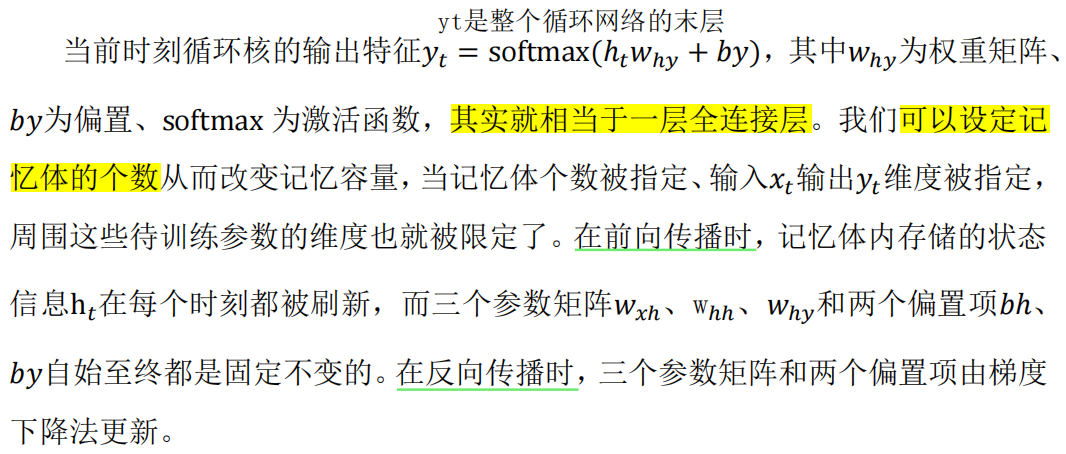
二循环核按时间步展开
就是把循环核按照时间轴方向展开如图
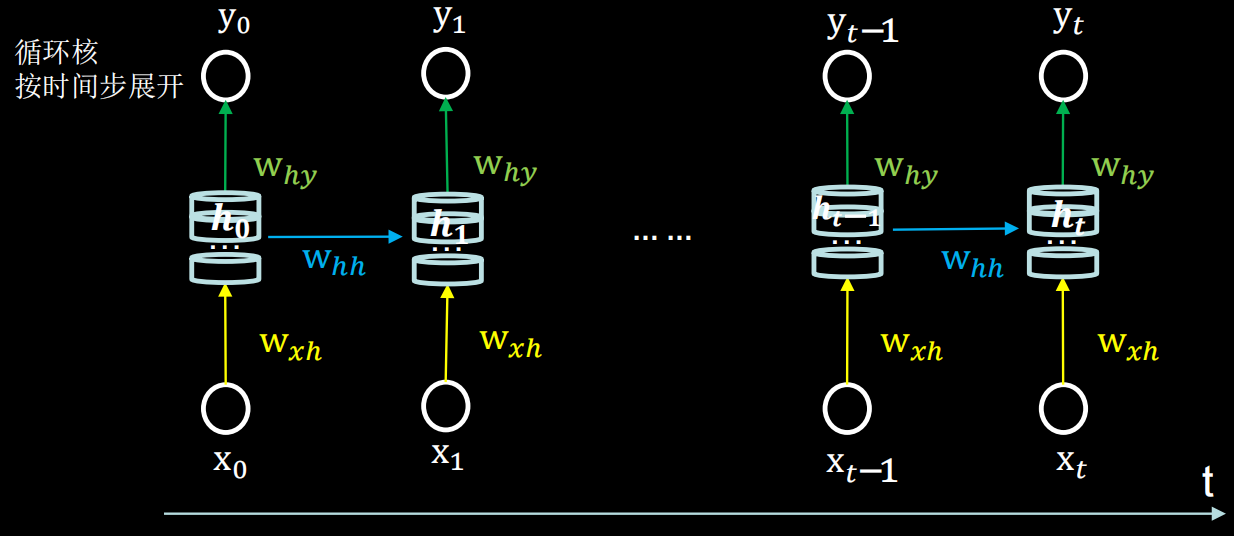

循环神经网络就是借助循环核实现时间特征提取后把提取到的信息送入全连接网络从而实现连续数据的预测
三循环计算层向输出方向增长
每个循环核构成一层循环计算层循环计算层的层数是向输出方向增长的
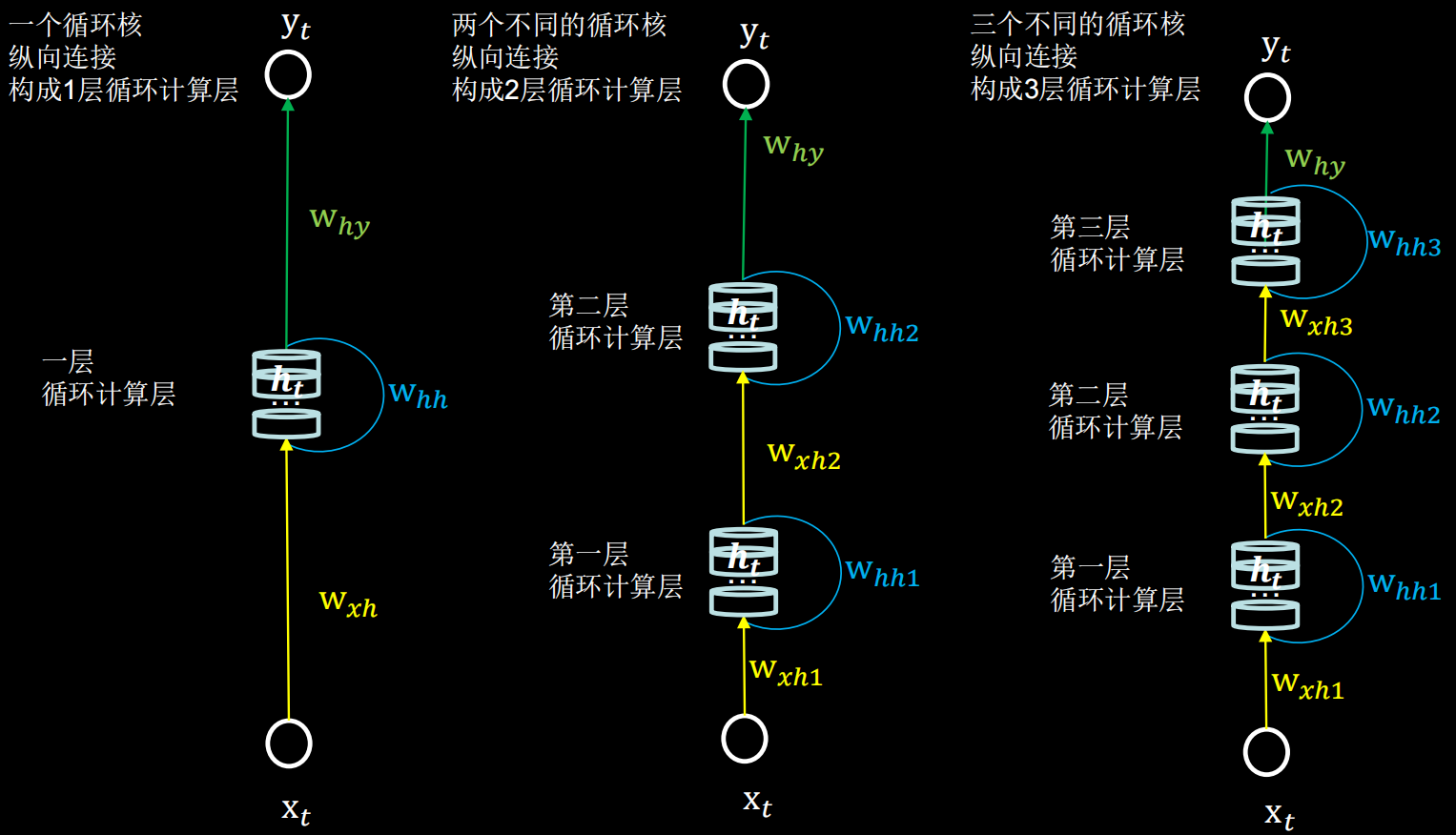
每个循环核中记忆体的个数可以根据需求任意指定
四TF2描述循环计算层
tf.keras.layers.SimpleRNN(
循环核中记忆体的个数/神经元个数
activation=‘激活函数’ # 使用什么激活函数计算ht。若不写默认用tanh
return_sequences=是否每个时刻输出ht到下一层 # True/False默认False
)参数return_sequences
在输出序列中返回最后时间步的输出值 False还是全部时间步的输出True
False还是全部时间步的输出True
当下一层依然是RNN层通常为True反之如果后面是Dense层通常为False。即最后一层的循环核用False仅在最后一个时间步输出 中间层的循环核用True每个时间步都把
中间层的循环核用True每个时间步都把 输出给下一层
输出给下一层
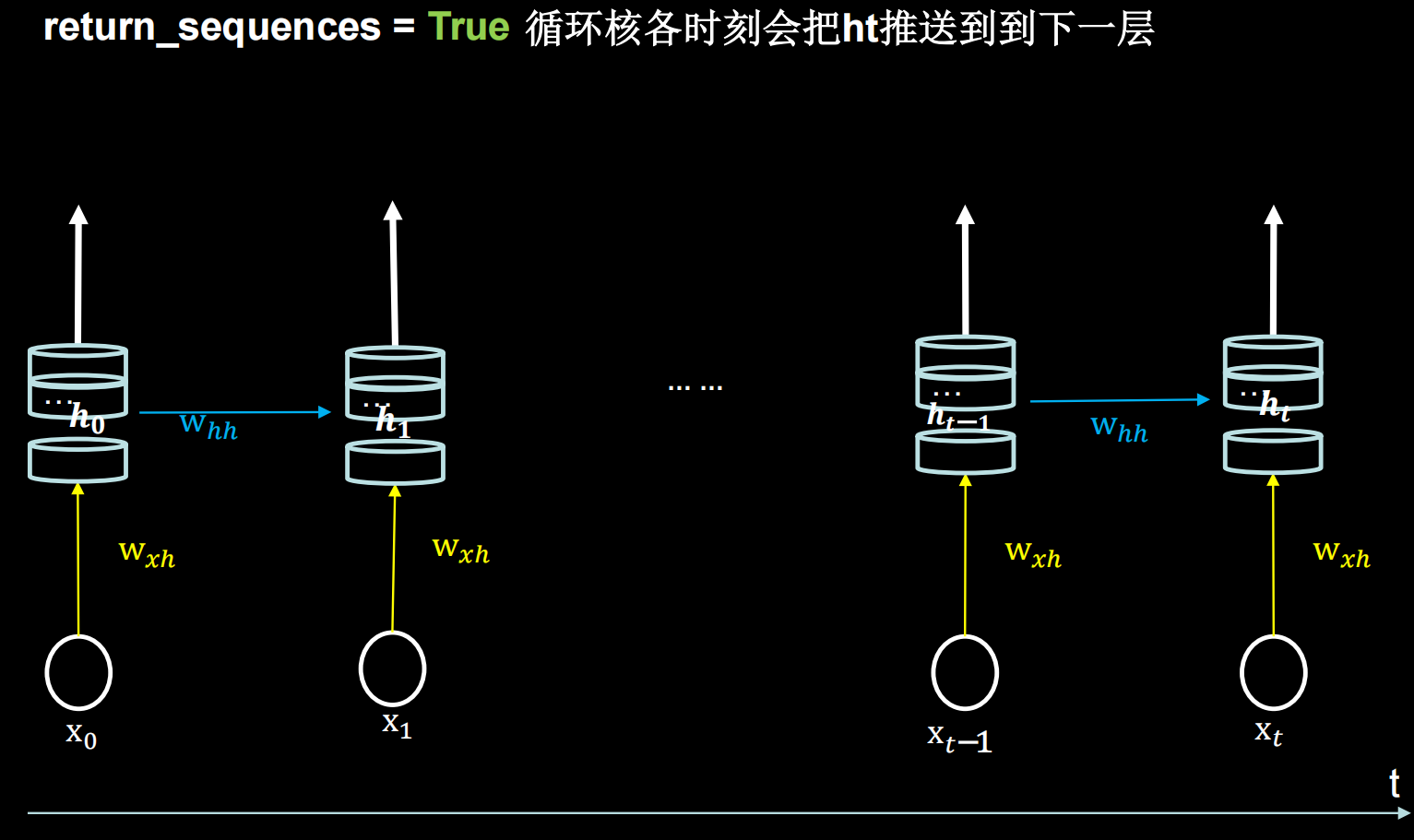
各时间步输出ht
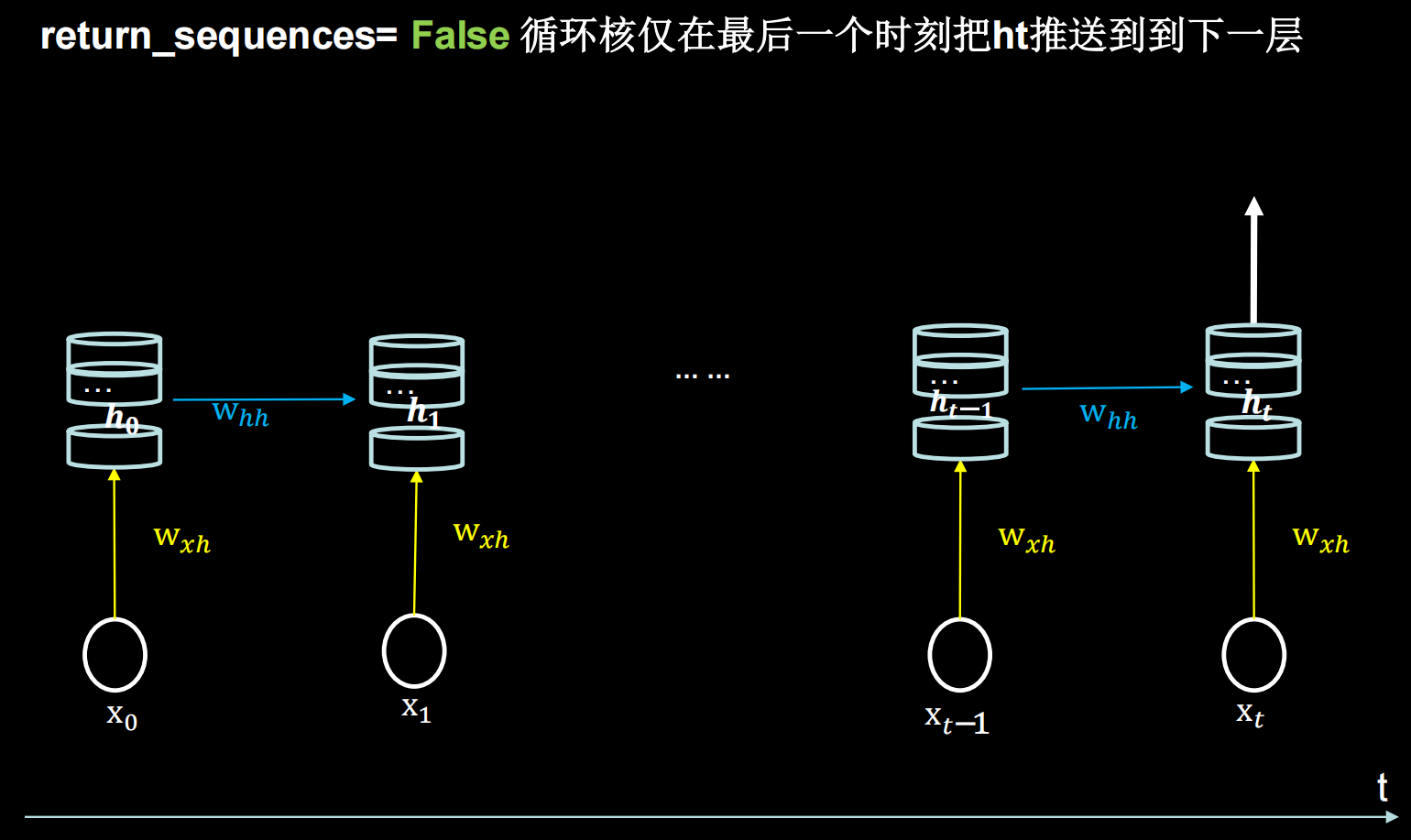
仅最后时间步输出ht
输入/输出维度
输入API对输入循环层的数据维度是有要求的是一个三维张量
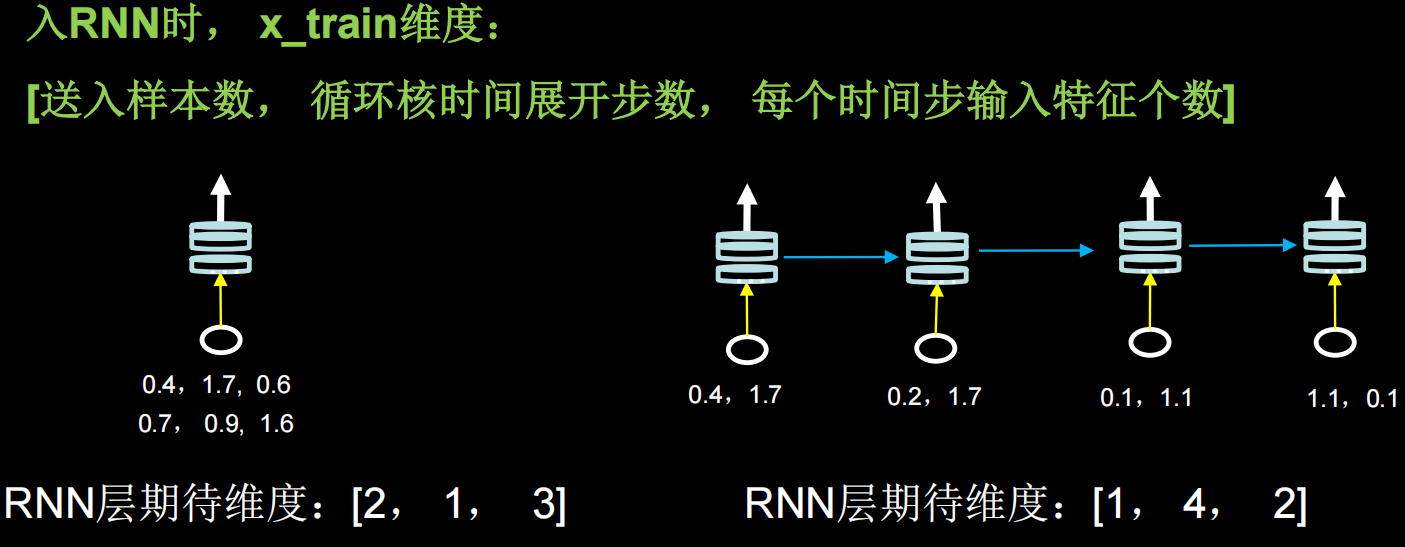
输出
当return_sequences=True时三维张量(输入样本数循环核时间展开步数本层神经元个数)
当return_sequences=False时二维张量(输入样本数本层神经元个数)
五循环计算过程
手动计算循环计算层的前向传播具体见实践字母预测
实践字母预测
RNN最典型的应用就是利用历史数据预测下一时刻将发生什么即根据以前见过的历史规律做预测。以字母预测的例子来说明循环网络的计算过程
计算机不认识字母只能处理数字所以需要对字母编码有独热编码one-hot和Embedding编码两种方式
one-hot编码
一1pre1输入一个字母预测下一个字母
如输入a 预测出 b、输入 b 预测出 c、输入 c 预测出 d、输入 d 预测出 e、输入 e 预测出 a

字母独热编码
假设使用一层 RNN 网络记忆体的个数选取 3随机生成了Wxh、Whh和Why三个参数矩阵。字母预测网络如下图



完整代码实现如下
# 用RNN实现输入一个字母预测下一个字母
# 字母使用独热码编码
import numpy as np
import tensorflow as tf
from keras.layers import Dense, SimpleRNN
import matplotlib.pyplot as plt
import os
input_word = "abcde"
w_to_id = {'a': 0, 'b': 1, 'c': 2, 'd': 3, 'e': 4} # 单词映射到数值id的词典
id_to_onehot = {0: [1., 0., 0., 0., 0.], 1: [0., 1., 0., 0., 0.], 2: [0., 0., 1., 0., 0.], 3: [0., 0., 0., 1., 0.], 4: [0., 0., 0., 0., 1.]} # id编码为one-hot
# 输入特征a对应标签b输入特征b对应标签c...以此类推
x_train = [id_to_onehot[w_to_id['a']], id_to_onehot[w_to_id['b']], id_to_onehot[w_to_id['c']],
id_to_onehot[w_to_id['d']], id_to_onehot[w_to_id['e']]]
y_train = [w_to_id['b'], w_to_id['c'], w_to_id['d'], w_to_id['e'], w_to_id['a']]
# 打乱顺序
np.random.seed(7)
np.random.shuffle(x_train)
np.random.seed(7)
np.random.shuffle(y_train)
tf.random.set_seed(7)
# 使x_train符合SimpleRNN的输入要求[送入样本数循环核时间展开步数每个时间步输入特征个数]
# 此处整个数据集送入故送入样本数为len(x_train)=5
# 输入1个字母出结果故循环核时间展开步数为1
# 表示为独热码有5个输入特征故每个时间步输入特征个数为5
x_train = np.reshape(x_train, (len(x_train), 1, 5))
y_train = np.array(y_train) # 把y_train变为numpy格式
# 构建模型
model = tf.keras.Sequential([
SimpleRNN(3), # 搭建具有3个记忆体的循环层记忆体个数越多记忆力越好但是占用资源会更多
Dense(5, activation='softmax') # 全连接实现了输出层yt的计算由于要映射到独热码编码找到输出概率最大的字母故为5
])
# 配置训练方法
model.compile(optimizer=tf.keras.optimizers.Adam(0.01), # 学习率
loss=tf.keras.losses.SparseCategoricalCrossentropy(from_logits=False),
metrics=['sparse_categorical_accuracy'])
# 断点续训
checkpoint_save_path = "./checkpoint/rnn_onehot_1pre1.ckpt"
if os.path.exists(checkpoint_save_path + '.index'):
print('-------------load the model-----------------')
model.load_weights(checkpoint_save_path)
cp_callback = tf.keras.callbacks.ModelCheckpoint(filepath=checkpoint_save_path,
save_weights_only=True,
save_best_only=True,
monitor='loss') # 由于fit没有给出测试集不计算测试集准确率根据loss保存最优模型
# 执行反向传播训练参数矩阵
history = model.fit(x_train, y_train, batch_size=32, epochs=100, callbacks=[cp_callback])
# 打印网络结构统计参数数目
model.summary()
# 提取参数
# print(model.trainable_variables)
file = open('./rnn_onehot_1pre1_weights.txt', 'w') # 参数提取
for v in model.trainable_variables:
file.write(str(v.name) + '\n')
file.write(str(v.shape) + '\n')
file.write(str(v.numpy()) + '\n')
file.close()
############################################### show ###############################################
# 显示训练集和验证集的acc和loss曲线
acc = history.history['sparse_categorical_accuracy']
loss = history.history['loss']
plt.subplot(1, 2, 1)
plt.plot(acc, label='Training Accuracy')
plt.title('Training Accuracy')
plt.legend()
plt.subplot(1, 2, 2)
plt.plot(loss, label='Training Loss')
plt.title('Training Loss')
plt.legend()
plt.show()
############### predict #############
# 展示预测效果
preNum = int(input("input the number of test alphabet:")) # 先输入要执行几次预测任务
for i in range(preNum):
alphabet1 = input("input test alphabet:") # 输入一个字母
alphabet = [id_to_onehot[w_to_id[alphabet1]]] # 把这个字母转换为独热码
# 使alphabet符合SimpleRNN输入要求[送入样本数循环核时间展开步数每个时间步输入特征个数]
# 此处验证效果送入了1个样本送入样本数为1
# 输入1个字母出结果所以循环核时间展开步数为1
# 表示为独热码有5个输入特征每个时间步输入特征个数为5
alphabet = np.reshape(alphabet, (1, 1, 5))
result = model.predict([alphabet]) # 得到预测结果
pred = tf.argmax(result, axis=1) # 选出预测结果最大的一个
pred = int(pred)
tf.print(alphabet1 + '->' + input_word[pred]) # input_word = "abcde"
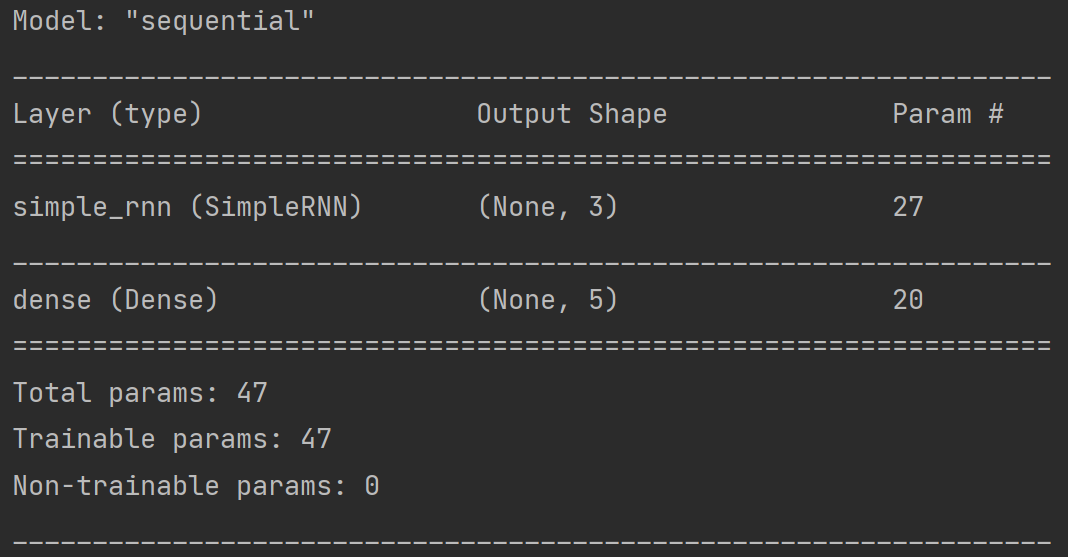
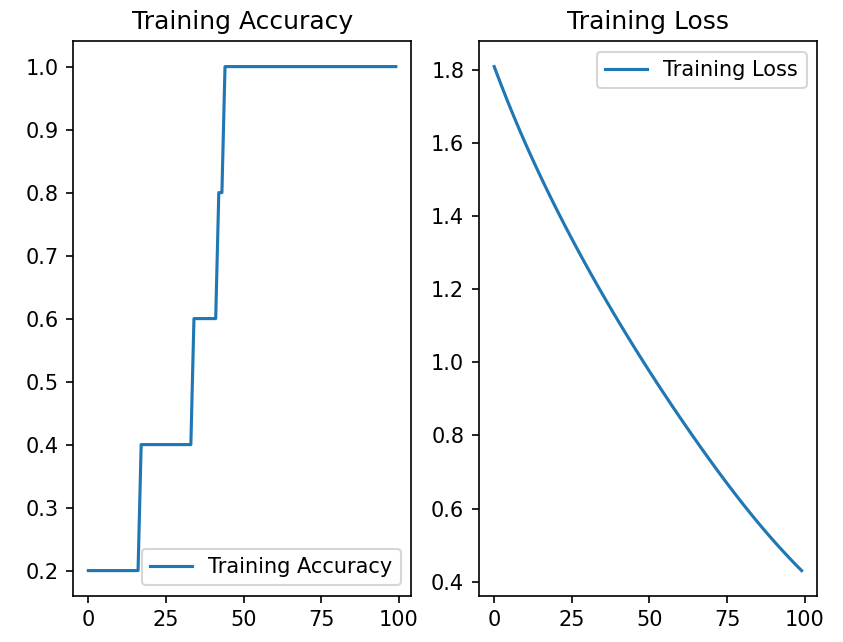
运行效果
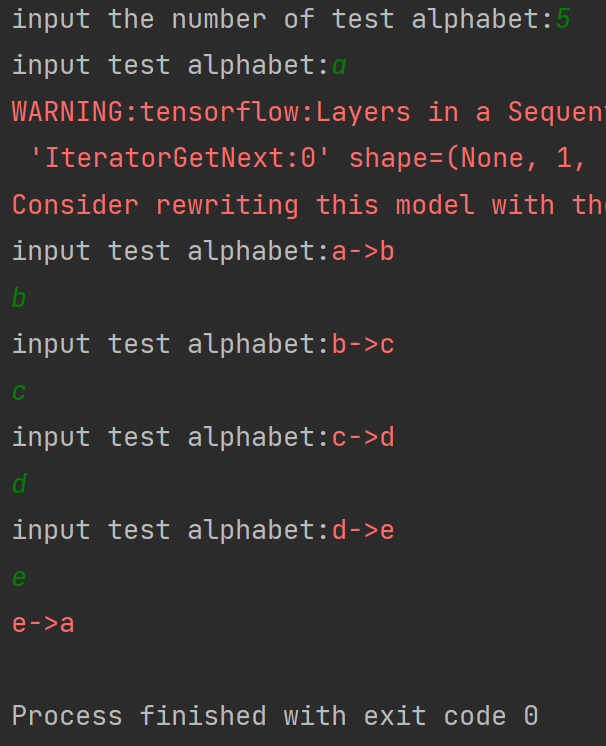
二多pre1连续输入多个字母预测下一个字母
把循环核按时间步展开连续输入多个字母预测下一个字母以连续输入4个字母预测下一个字母为例即输入abcd输出e输入bcde输出a输入cdea输出b输入deab输出c输入eabc输出d
仍然使用三个记忆体初始时刻记忆体内的记忆是 0用一套训练好的参数矩阵感受循环计算的前向传播过程在这个过程中每个时刻参数矩阵是固定的记忆体会在每个时刻被更新
下面以输入 bcde 预测 a 为例
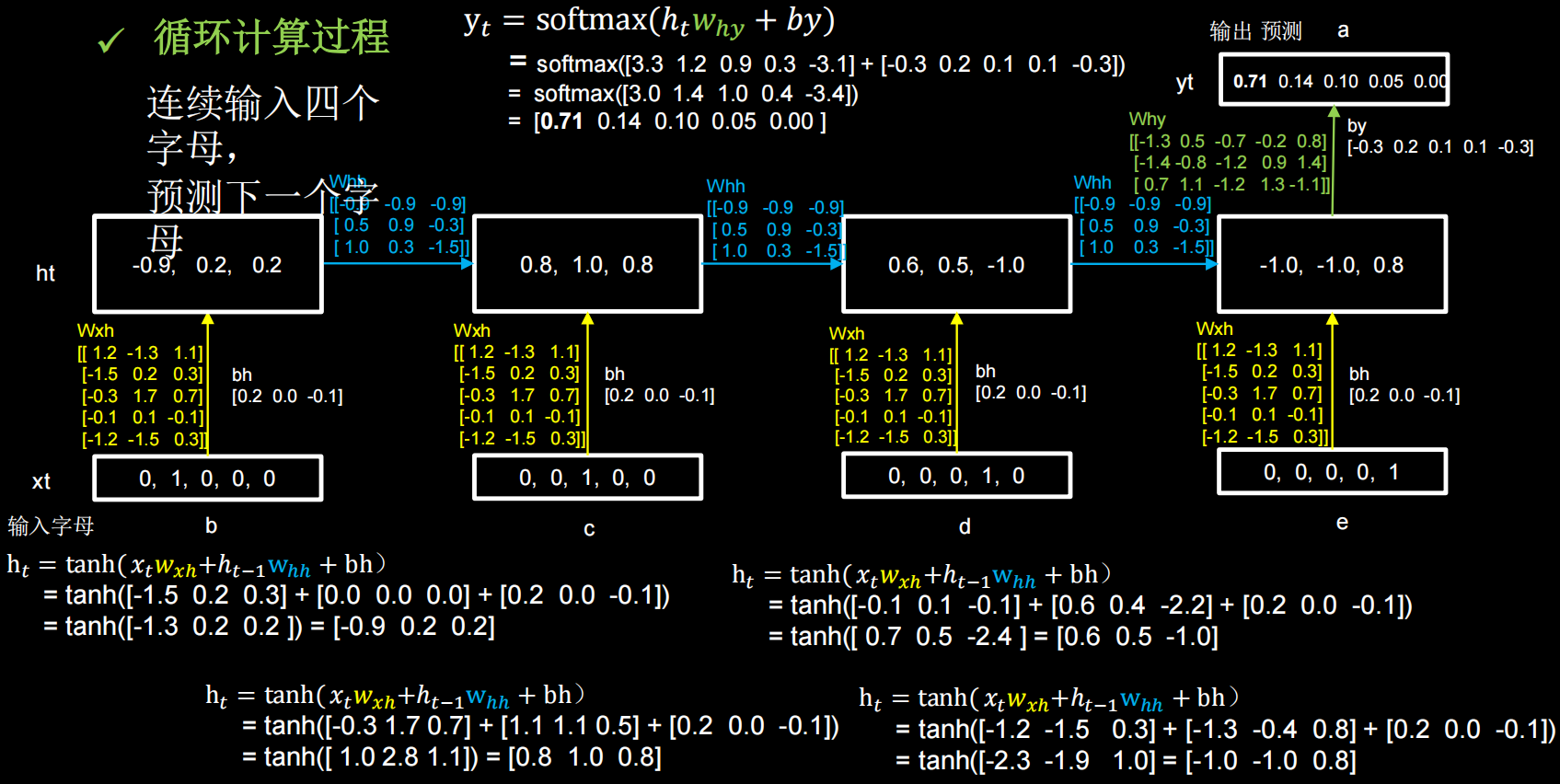
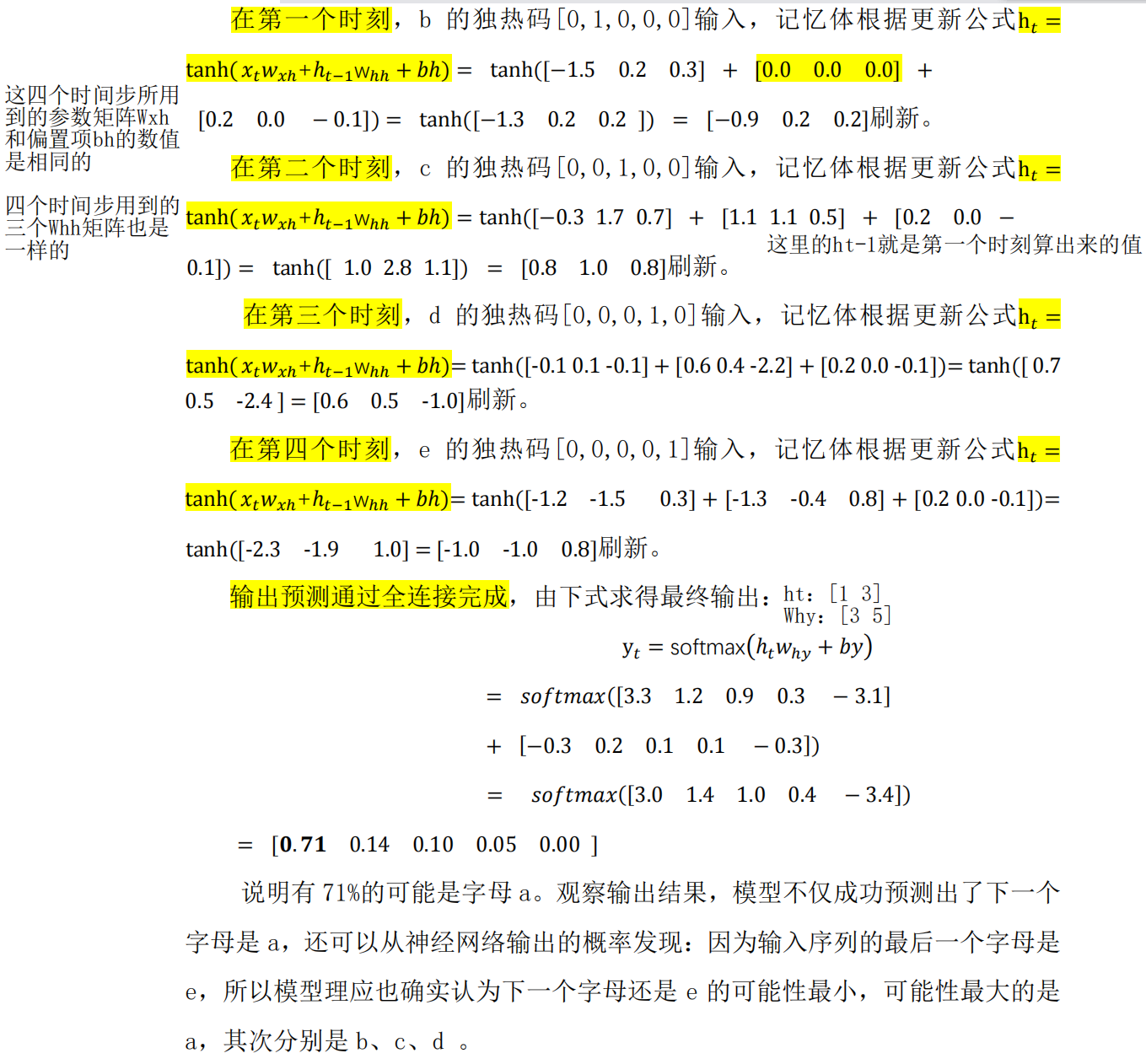
代码实现如下只列出与rnn_onehot_1pre1.py代码不同的地方
# 连续输入四个字母预测下一个字母
# 字母使用独热码编码
input_word = "abcde"
w_to_id = {'a': 0, 'b': 1, 'c': 2, 'd': 3, 'e': 4} # 单词映射到数值id的词典
id_to_onehot = {0: [1., 0., 0., 0., 0.], 1: [0., 1., 0., 0., 0.], 2: [0., 0., 1., 0., 0.], 3: [0., 0., 0., 1., 0.], 4: [0., 0., 0., 0., 1.]} # id编码为one-hot
'''
输入连续的abcd对应的标签是e
输入连续的bcde对应的标签是a
输入连续的cdea对应的标签是b
输入连续的deab对应的标签是c
输入连续的eabc对应的标签是d
'''
x_train = [
[id_to_onehot[w_to_id['a']], id_to_onehot[w_to_id['b']], id_to_onehot[w_to_id['c']], id_to_onehot[w_to_id['d']]],
[id_to_onehot[w_to_id['b']], id_to_onehot[w_to_id['c']], id_to_onehot[w_to_id['d']], id_to_onehot[w_to_id['e']]],
[id_to_onehot[w_to_id['c']], id_to_onehot[w_to_id['d']], id_to_onehot[w_to_id['e']], id_to_onehot[w_to_id['a']]],
[id_to_onehot[w_to_id['d']], id_to_onehot[w_to_id['e']], id_to_onehot[w_to_id['a']], id_to_onehot[w_to_id['b']]],
[id_to_onehot[w_to_id['e']], id_to_onehot[w_to_id['a']], id_to_onehot[w_to_id['b']], id_to_onehot[w_to_id['c']]],
]
y_train = [w_to_id['e'], w_to_id['a'], w_to_id['b'], w_to_id['c'], w_to_id['d']]
# 使x_train符合SimpleRNN输入要求[送入样本数循环核时间展开步数每个时间步输入特征个数]。
# 此处整个数据集送入送入样本数为len(x_train)=5
# 输入4个字母出结果四个字母通过四个连续的时刻输入网络循环核时间展开步数为4
# 表示为独热码有5个输入特征每个时间步输入特征个数为5
x_train = np.reshape(x_train, (len(x_train), 4, 5))
y_train = np.array(y_train)
############### predict #############
preNum = int(input("input the number of test alphabet:"))
for i in range(preNum):
alphabet1 = input("input test alphabet:") # 等待连续输入四个字母
alphabet = [id_to_onehot[w_to_id[a]] for a in alphabet1] # 把这四个字母转换为独热码
# 使alphabet符合SimpleRNN输入要求[送入样本数循环核时间展开步数每个时间步输入特征个数]
# 此处验证效果送入了1个样本送入样本数为1
# 输入4个字母出结果所以循环核时间展开步数为4
# 表示为独热码有5个输入特征每个时间步输入特征个数为5
alphabet = np.reshape(alphabet, (1, 4, 5))
result = model.predict([alphabet])
pred = tf.argmax(result, axis=1)
pred = int(pred)
tf.print(alphabet1 + '->' + input_word[pred])


运行效果
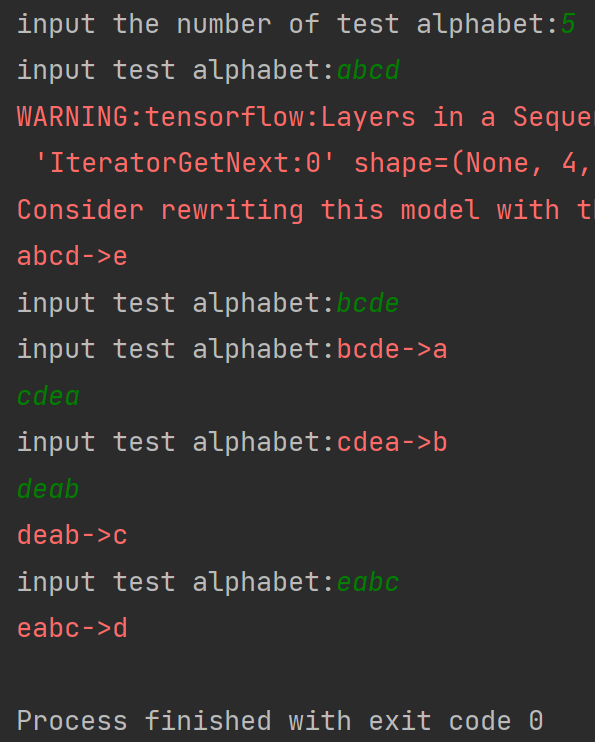
Embedding编码
独热码的位宽要与词汇量一致若词汇量增大时非常浪费资源独热码的缺点数据量大、过于稀疏、映射之间是独立的没有表现出关联性
Embedding是一种单词编码方法用低维向量实现了编码。这种编码通过神经网络训练优化能表达出单词间的相关性
Tensorflow2中的词向量空间编码层
输入维度二维张量 [送入样本数循环核时间展开步数]
输出维度三维张量 [送入样本数循环核时间展开步数编码维度]
tf.keras.layers.Embedding(词汇表大小编码维度)
# 词汇表大小编码一共要表示多少个单词
# 编码维度用几个数字表达一个单词在Sequential搭建网络时相比于one-hot形式增加了一层Embedding层
一1pre1输入一个字母预测下一个字母
代码实现如下只列出与rnn_onehot_1pre1.py不同的地方
# 用RNN实现输入一个字母预测下一个字母
# 字母使用Embedding编码
from keras.layers import Dense, SimpleRNN, Embedding
input_word = "abcde"
w_to_id = {'a': 0, 'b': 1, 'c': 2, 'd': 3, 'e': 4} # 单词映射到数值id的词典
x_train = [w_to_id['a'], w_to_id['b'], w_to_id['c'], w_to_id['d'], w_to_id['e']]
y_train = [w_to_id['b'], w_to_id['c'], w_to_id['d'], w_to_id['e'], w_to_id['a']]
# 使x_train符合Embedding输入要求[送入样本数循环核时间展开步数]
# 此处整个数据集送入所以送入样本数为len(x_train)=5
# 输入1个字母出结果循环核时间展开步数为1
x_train = np.reshape(x_train, (len(x_train), 1))
y_train = np.array(y_train) # 把y_train变为numpy格式
# 搭建网络
model = tf.keras.Sequential([
Embedding(5, 2), # 对输入数据进行编码生成一个五行两列的可训练参数矩阵实现编码可训练
SimpleRNN(3), # 设定具有3个记忆体的循环层
Dense(5, activation='softmax') # 设定全连接Dense层实现输出层y的全连接计算
])
############### predict #############
preNum = int(input("input the number of test alphabet:"))
for i in range(preNum):
alphabet1 = input("input test alphabet:")
alphabet = [w_to_id[alphabet1]] # 把读到的输入字母直接查找表示它的ID值
# 使alphabet符合Embedding输入要求[送入样本数循环核时间展开步数]
# 此处验证效果送入了1个样本送入样本数为1
# 输入1个字母出结果循环核时间展开步数为1
alphabet = np.reshape(alphabet, (1, 1))
result = model.predict(alphabet)
pred = tf.argmax(result, axis=1)
pred = int(pred)
tf.print(alphabet1 + '->' + input_word[pred])

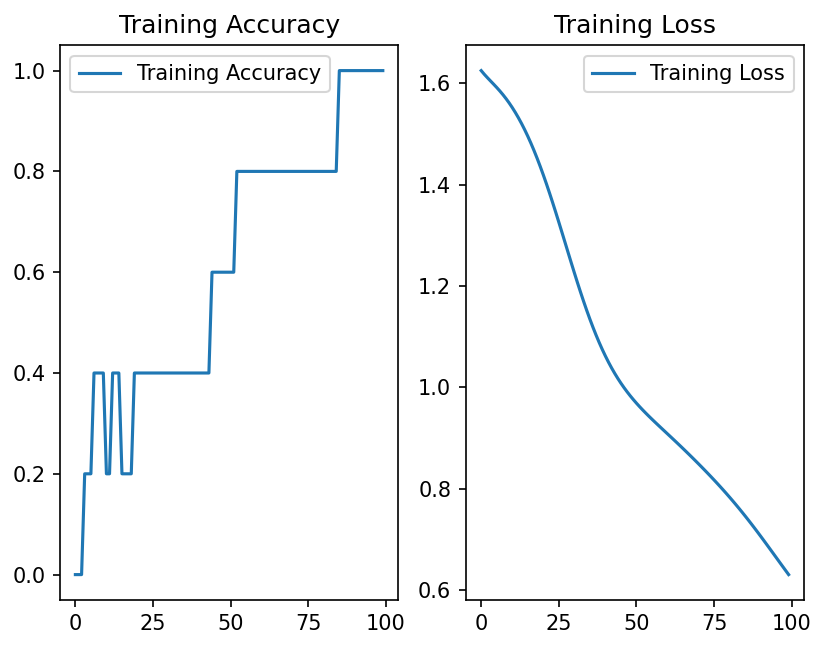
运行效果如下
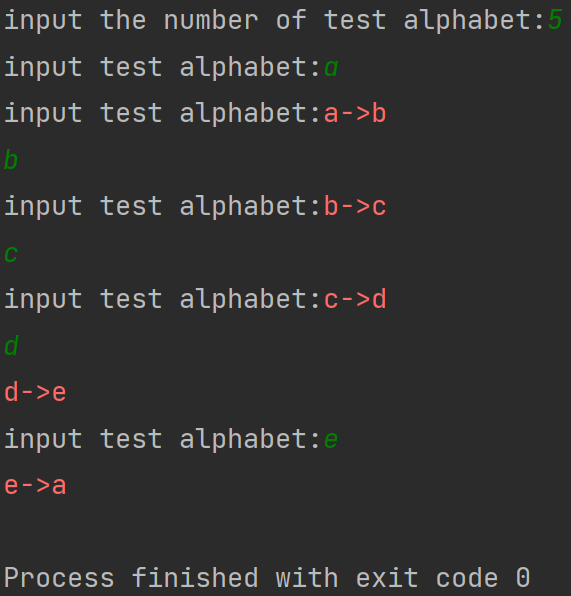
二多pre1连续输入多个字母预测下一个字母
将词汇量扩充到26个A-Z
代码实现如下只列出与rnn_onehot_1pre1.py不同的地方
# 连续输入四个字母预测下一个字母
# 字母使用Embedding编码
from keras.layers import Dense, SimpleRNN, Embedding
input_word = "abcdefghijklmnopqrstuvwxyz" # 26个字母
# 建立一个映射表把字母用数字表示为0-25
w_to_id = {'a': 0, 'b': 1, 'c': 2, 'd': 3, 'e': 4,
'f': 5, 'g': 6, 'h': 7, 'i': 8, 'j': 9,
'k': 10, 'l': 11, 'm': 12, 'n': 13, 'o': 14,
'p': 15, 'q': 16, 'r': 17, 's': 18, 't': 19,
'u': 20, 'v': 21, 'w': 22, 'x': 23, 'y': 24, 'z': 25} # 单词映射到数值id的词典
training_set_scaled = [0, 1, 2, 3, 4, 5, 6, 7, 8, 9, 10,
11, 12, 13, 14, 15, 16, 17, 18, 19, 20,
21, 22, 23, 24, 25]
x_train = []
y_train = []
# 用for循环从数字列表中把连续4个数作为输入特征添加到x_train第5个数作为标签添加到y_train
for i in range(4, 26):
x_train.append(training_set_scaled[i - 4:i])
y_train.append(training_set_scaled[i])
# 使x_train符合Embedding输入要求[送入样本数循环核时间展开步数]
# 此处整个数据集送入所以送入送入样本数为len(x_train)=2226个字母连续取4个可以得到22组
# 输入4个字母出结果循环核时间展开步数为4
x_train = np.reshape(x_train, (len(x_train), 4))
y_train = np.array(y_train)
# 搭建网络
model = tf.keras.Sequential([
Embedding(26, 2), # 词汇量是26每个单词用2个数值编码生成一个26行2列的可训练参数矩阵实现编码可训练
SimpleRNN(10), # 设定具有10个记忆体的循环层
Dense(26, activation='softmax') # 全连接层实现输出层yt的计算输出会是26个字母之一
])
################# predict ##################
preNum = int(input("input the number of test alphabet:")) # 先输入要执行几次检测
for i in range(preNum):
alphabet1 = input("input test alphabet:") # 等待连续输入四个字母
alphabet = [w_to_id[a] for a in alphabet1]
# 使alphabet符合Embedding输入要求[送入样本数时间展开步数]
# 此处验证效果送入了1个样本送入样本数为1
# 输入4个字母出结果循环核时间展开步数为4
alphabet = np.reshape(alphabet, (1, 4))
result = model.predict([alphabet]) # 输入网络进行预测
pred = tf.argmax(result, axis=1) # 选出预测结果最大的一个
pred = int(pred)
tf.print(alphabet1 + '->' + input_word[pred])
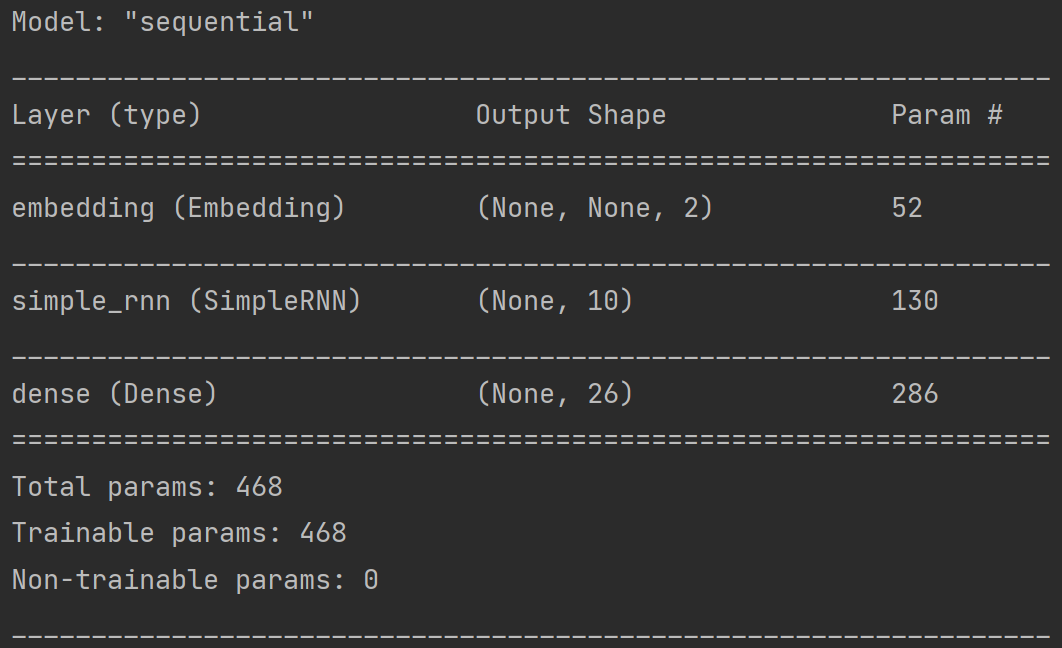

运行效果
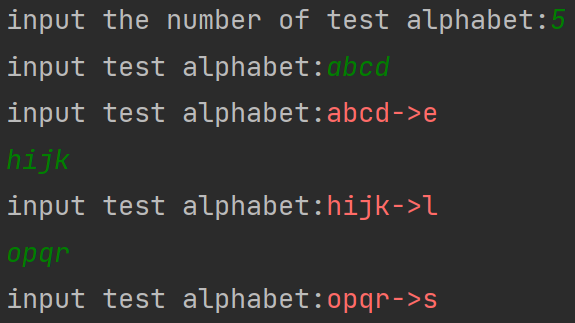
实践股票预测
RNN
LSTM
GRU

